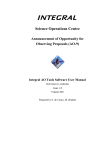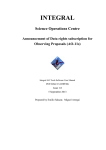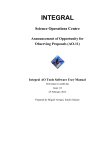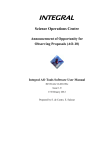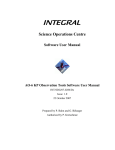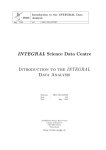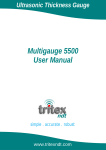Download Integral AO Tools Software User Manual
Transcript
INTEGRAL Science Operations Centre Announcement of Opportunity for Observing Proposals (AO-9) Integral AO Tools Software User Manual INT/OAG/11-0354/Dc Issue 1.0 5 September 2011 Prepared by S. de Castro, M. Bindels Doc.No: INTEGRAL Integral AO Tools Software User Manual Issue: Date: Page: INT/OAG/11-0354/Dc 1.0 5 September 2011 2 of 19 Document Status Sheet Document Title Integral AO Tools Software User Manual Reference No: INT/OAG/11-0354/Dc Issue Revision Date Reason for change 1 0 5 September 2011 Issue for AO-9 Second Phase INTEGRAL Integral AO Tools Software User Manual Doc.No: Issue: Date: Page: INT/OAG/11-0354/Dc 1.0 5 September 2011 3 of 19 Table of Contents 1 2 3 4 5 6 Introduction ..............................................................................................................................4 Proposal Generation Tool (PGT) .............................................................................................5 2.1 Entering data......................................................................................................................5 2.1.1 The Main Panel ...........................................................................................................5 2.1.2 The Admin, Proposal and Observation Details Panels ...............................................6 2.2 Saving, loading and printing..............................................................................................9 2.2.1 Saving .........................................................................................................................9 2.2.2 Loading .......................................................................................................................9 2.2.3 Printing......................................................................................................................10 2.3 Submitting a proposal to ISOC........................................................................................10 2.3.1 Submitting for the first time......................................................................................11 2.3.2 Resubmitting a proposal ...........................................................................................12 2.3.3 Obtaining a copy of a submitted proposal from ISOC .............................................12 Observing Time Estimator (OTE)..........................................................................................13 3.1 Using OTE.......................................................................................................................13 3.1.1 Input ..........................................................................................................................13 3.1.2 Output .......................................................................................................................14 3.2 Continuum calculations: a note on energy ranges ...........................................................14 3.3 Hints and warnings ..........................................................................................................14 Target Visibility Predictor (TVP) ..........................................................................................16 4.1 Viewing constraints .........................................................................................................16 4.2 How visibility is calculated .............................................................................................16 4.3 Using TVP .......................................................................................................................16 4.3.1 Input ..........................................................................................................................16 4.3.2 Output .......................................................................................................................17 Exposure Map Tool (EMT)....................................................................................................18 5.1 Using EMT ......................................................................................................................18 5.1.1 Input ..........................................................................................................................18 5.1.2 Output .......................................................................................................................18 Proposal Query Tool (PQT) ...................................................................................................19 6.1 Using PQT .......................................................................................................................19 6.1.1 Input ..........................................................................................................................19 6.1.2 Output .......................................................................................................................19 INTEGRAL Integral AO Tools Software User Manual 1 Doc.No: Issue: Date: Page: INT/OAG/11-0354/Dc 1.0 5 September 2011 4 of 19 Introduction The purpose of this document is to describe the use of the software tools made available to observers who wish to submit a proposal for INTEGRAL observations. The Integral AO Tools provided by the INTEGRAL Science Operations Centre (ISOC) include: the Proposal Generation Tool (PGT), the Observation Time Estimator (OTE), the Target Visibility Predictor (TVP), the Exposure Map Tool (EMT) and the Proposal Query Tool (PQT). The latest version of these tools together with the associated documentation is available from the ISOC web page: http://integral.esac.esa.int. If you discover a problem with any of the tools, please read the Frequently Asked Questions (FAQ) at http://www.sciops.esa.int/index.php?project=INTEGRAL&page=FAQ. If you do not find the answer to your question, please contact the INTEGRAL Helpdesk: [email protected]. INTEGRAL Doc.No: Integral AO Tools Software User Manual 2 INT/OAG/11-0354/Dc Issue: Date: Page: 1.0 5 September 2011 5 of 19 Proposal Generation Tool (PGT) PGT can be downloaded from http://www.sciops.esa.int/index.php?project=INTEGRAL&page=AO8S_PGT There are two ways to install PGT: Manual installation (recommended) Step 1: Download (Save as...) PGT-install.jar. Step 2: Start the installer. If you are using Windows (and newer versions of Mac): Open the PGT-install.jar file by double-clicking on it. For other operating systems: Start the installer from the command line: java -jar PGT-install.jar (you must be in the same directory as the PGT-install.jar file). Automatic installation (only if you have Java™ Web Start installed) Launch the PGT installer with Java™ Web Start using the link available in the page (Install PGT using Java™ Web Start) See the FAQ section (http://www.sciops.esa.int/index.php?project=INTEGRAL&page=AO8S_PGT#faq) if you experience problems. Once PGT has been successfully installed, it is launched by running an executable script called ‘pgt’ on UNIX-like platforms, clicking on the icon of the “Application” folder on Mac systems or by double-clicking on the desktop icon on Windows systems. 2.1 Entering data 2.1.1 The Main Panel When the PGT is launched, the Main Panel is displayed (Figure 1). This panel serves as the parent to the Admin Details Panel, the Proposal Details Panel and the Data Rights Panel, all of which can be accessed by clicking the appropriate button found in the top half of the Main Panel. INTEGRAL Integral AO Tools Software User Manual Doc.No: Issue: Date: Page: INT/OAG/11-0354/Dc 1.0 5 September 2011 6 of 19 Figure 1 - The Main Panel of PGT Below these three buttons, there is a Check Proposal button that initiates a series of checks on the proposal and lists anything that is wrong or incomplete. This check can be performed at any time. The lower half of the Main Panel controls proposal submission (or resubmission). Clicking the Submit Proposal to ISOC button, will send an electronic version of the proposal to the ISOC and you will be given an assigned number (the proposal ID), for any possible further submission of the same proposal to ISOC. 2.1.2 The Admin, Proposal and Data Rights Panels PGT provides three details panels that encompass all the information about the proposal. These include: administrative details, proposal details and observation details, and are accessed by clicking the corresponding button in the Main Panel. All fields, in any panel, that have a light yellow background are mandatory and cannot be left blank. 2.1.2.1 Admin Details Panel This panel serves to enter contact information for the principal investigator. 2.1.2.2 Proposal Details Panel This panel serves to enter the title and abstract of the proposal, its scientific category and to attach the scientific justification. Selecting the proposals to subscribe to is also done here. Scientific Justification At the bottom of the Proposal Details Panel, the button labelled Sci. Justification Attachment (see Figure 2) is used to attach the proposal’s scientific justification in PDF format. INTEGRAL Integral AO Tools Software User Manual Doc.No: Issue: Date: Page: INT/OAG/11-0354/Dc 1.0 5 September 2011 7 of 19 Figure 2 – The Proposal Details Panel (bottom part) Having selected the attachment, the name of the file will be shown in the Current Attachment box of the Proposal Details Panel. Saving the proposal does not save the attachment, but the full path to access it. Hence, there is no need to re-attach the file every time the proposal is loaded, except if you have changed the location of the file. There is no need to ever remove an attachment; only the last attachment is used. Selecting Panel → Reset will clear all fields and also remove the attachment. Subscribing to proposals At the bottom of the panel, (see figure 2), there is a table showing the accepted proposals for AO-9. Each proposal has a checkbox. It is possible to subscribe to different proposals by clicking the checkboxes. PGT does not prevent you from subscribing to proposals whose field of view does not cover any of your sources. Verifying adequate exposure time for the sources is at the responsibility of the PI and is easily done using the Proposal Query Tool 1 (see Chapter 6 for more information and a link). Double clicking the proposal id or title, brings up the science case and other details in your web browser. The accepted proposals by Russian PIs have been marked with a flag; subscription to these proposals is subject to conditions laid out in the AO documentation 2.1.2.3 Data Rights Panel This panel serves to enter the technical details of each data rights included in the proposal (see Figure 3). 1 http://integral.esac.esa.int/isocweb/queryProposals.html?action=query INTEGRAL Integral AO Tools Software User Manual Doc.No: Issue: Date: Page: INT/OAG/11-0354/Dc 1.0 5 September 2011 8 of 19 As only subscriptions are accepted during this phase, only the target source information has to be provided because all instrument settings are defined in the proposal/s to subscribe to. In the Source section of the panel, the name of the source entered in the Name field is checked against the Simbad, NED and VisieR astronomical databases when pressing the “Check Proposal” button in the Main Panel. After inserting the Name of your source you can press “ctrl+space” to get Simbad coordinates of your source into the corresponding fields (Ra, Dec). If the source name is not found, (i.e. because it is unknown) a warning will appear in the Check Panel. In addition to the two menu items that appear on all PGT panels, namely Panel and Help, the Data rights Panel has another one labelled Data rights (see Figure 4). Under this menu item, you can perform a number of actions: add a new data rigths (the display will show the new data rights), delete, duplicate or check the currently displayed data rights and go to a particular one. copy n, makes “n” copies of the current data rights, and delete n, deletes the range of data rights specified and import source list allows importing a list of sources from a text file which format uses tab character between the source name and the coordinates (RA (J2000) hr:min:sec, DEC (J2000) deg:arcmin:arcsec), or by entering these fields directly into the table. The action “Generate data rights from observations” is disabled during this phase. Finally, Query proposals on the Web, will open a browser to the Proposal Query Tool, querying all your sources. Figure 3 - The Data rights Panel INTEGRAL Integral AO Tools Software User Manual Doc.No: Issue: Date: Page: INT/OAG/11-0354/Dc 1.0 5 September 2011 9 of 19 Figure 4 - The Data Rights Menu Figure 5 – Import source list 2.2 Saving, loading and printing 2.2.1 Saving To save a proposal at any time, select File → Save in the menu of the Main Panel (see Figure 1). The save functionality has changed from previous versions of PGT. Now, it will save your proposal in a well-formed xml file. 2.2.2 Loading To load a saved proposal, select File → Open in the menu of the Main Panel. It will ask for a xml file, the standard format since AO-7, so you will need to generate it, using the save button, or ask to ISOC support team by sending an email to the ISOC Helpdesk ([email protected]) stating that you would like a copy of your proposal in xml format referring to it with the corresponding Proposal ID. INTEGRAL Doc.No: Integral AO Tools Software User Manual Issue: Date: Page: INT/OAG/11-0354/Dc 1.0 5 September 2011 10 of 19 Old xml files can be loaded, but it might be necessary to update some information (old subscriptions will not be valid anymore, and its information shall be entered again with the current available proposals). If you modify the xml file on disk with other tools, it might not be a valid PGT xml file any more and you might not be able to load your proposal. 2.2.3 Printing To print a proposal or parts of it, first choose the printing options by selecting File → Print → Options in the menu of the Main Panel. This will open the Print Options dialog box (see Fig 6). Figure 6 - The Print Options dialogue Two paper sizes are supported, A4 and US letter. Click on the appropriate button at the top of the dialogue to choose the paper size. The list of fonts from which you can select will appear below. After having selected the paper size and font, set them by clicking OK, or Cancel to disregard the selection and close the dialogue. To print the entire proposal, select File → Print → Proposal in the menu of the Main Panel. A Print dialogue will appear and allow you to select a destination (printer or file) and start the print job. The exact appearance of this dialogue will depend on the platform you are using. The administrative details and the proposal details can be printed individually by selecting Panel → Print in the menu bar of the corresponding panel. Data rights details can be printed by selecting Panel → Print. 2.3 Submitting a proposal to ISOC The PGT allows you to send your proposal electronically to the ISOC. To do this, your computer must be connected to the Internet. INTEGRAL Integral AO Tools Software User Manual Doc.No: Issue: Date: Page: INT/OAG/11-0354/Dc 1.0 5 September 2011 11 of 19 2.3.1 Submitting for the first time Clicking the Submit Proposal to ISOC button in the lower part of the Main Panel (see Figure 1) starts the submission process. PGT will first check your proposal. If it fails any checks, the submission process will be aborted and you will need to correct the errors shown in the Failed Checks Panel. If it passes the checks, there might be also some warnings shown in the Failed Checks Panel, but they will not prevent proposal submission. Then, a panel is displayed showing a summary of the proposal (see Figure 7). Click Submit to send the proposal, Cancel to abort the submission. Figure 7 - The Summary Panel By clicking Submit, PGT will attempt to establish a connection with a computer at ISOC that has been set up to receive proposals. Once it is established, the proposal will be sent. If the proposal was sent successfully, the following dialogue will be displayed (Figure 8). Figure 8 - Successful Submission dialogue INTEGRAL Integral AO Tools Software User Manual Doc.No: Issue: Date: Page: INT/OAG/11-0354/Dc 1.0 5 September 2011 12 of 19 Upon receipt of a proposal, the computer at the ISOC performs further checks and sends a receipt confirmation e-mail message. This e-mail can take some time (around 20 min.). If the proposal passes the checks, a Proposal ID will be assigned to it and included in the message. If it does not, this will be stated in the email. 2.3.2 Resubmitting a proposal If you realise you have made a mistake, or simply want to make changes to a proposal you have already submitted, you can resubmit a proposal using the Proposal ID. Make the changes you wish to make to the proposal and enter the Proposal ID in the box provided at the bottom of the Main Panel (see Figure 1). The Resubmit Proposal to ISOC button will be enabled and the Submit Proposal to ISOC button will be disabled. When you click the Resubmit Proposal to ISOC button, PGT will repeat the proposal submission process, described above. The computer at ISOC will use the Proposal ID entered to find the previous version of the proposal in the ISOC database. If it is found, the resubmitted proposal will replace the previous one. If it is not found, the receipt confirmation email message will inform you of that fact (make sure the Proposal ID is correct). In either of these cases, simply submit the proposal as a new one, without specifying an ID. You will then be given a new ID that is compatible with your selection. PGT cannot prevent a proposer from submitting the same proposal multiple times as new proposals. A new Proposal ID will be generated for each new submission. Therefore, be cautious when resubmitting a modified version of the same proposal. 2.3.3 Obtaining a copy of a submitted proposal from ISOC After submitting a proposal, it should be saved (see section 2.2) for future reference, and to allow for the possibility of resubmitting the proposal at a later date. You can also request a copy of your proposal by sending an email to the ISOC Helpdesk ([email protected]) stating that you would like a copy of your proposal, referring to it with the corresponding Proposal ID. It will be emailed to you at the address specified in the Admin Details Panel of PGT. If another email address should be used, specify this in the message. INTEGRAL Integral AO Tools Software User Manual 3 Doc.No: Issue: Date: Page: INT/OAG/11-0354/Dc 1.0 5 September 2011 13 of 19 Observing Time Estimator (OTE) The Observing Time Estimator (OTE) is a web-based tool running at the INTEGRAL Science Operations Centre at ESAC and made available to potential observers. The purpose of OTE is to give users a reliable guide as to the feasibility of their proposed observation. For example, given specific source characteristics (spectrum, flux), OTE computes the signal-to-noise ratio (S/N) achievable in a given observing time, or conversely, the integration time needed to achieve a desired S/N. OTE can currently be used only for INTEGRAL’s main instruments: SPI and IBIS. Not for JEM-X and OMC (interested users should refer to the JEM-X and OMC Observer’s manual for details). All INTEGRAL proposers shall use OTE in determining the duration of their proposed observations. Output of the OTE only will be used by ISOC during the technical feasibility assessment and during the proposal evaluation by TAC.. OTE is accessed via the ISOC web site, http://integral.esac.esa.int, under ‘INTEGRAL Observation Tools’. 3.1 Using OTE 3.1.1 Input Select an instrument: SPI or IBIS. Select a continuum or line source. - For a continuum calculation the user must set the lower and upper energies. The allowed range is 15 keV–10 MeV. OTE assumes a power law spectrum and the photon spectral index must be specified. If you wish to perform calculations for a continuum source, please make sure to read section 3.2. - For a line source, input the central energy and line width (FWHM). If the line is unresolved, a line width of 0.1 keV is sufficient. Specify the S/N or the exposure time. Specify the source flux. - This is the integrated broad-band flux, in units of photons cm-2 s-1, in either the selected energy range (for the continuum) or integrated over the full width at zero intensity (FWZI) for a line. Beware! The continuum sensitivity curves in the SPI and IBIS Observer’s manuals are presented using different units: monochromatic flux density, i.e., photons cm-2 s-1 keV-1. - Enter the source position (optional) in either degrees or sexagesimal notation (J2000). OTE accesses the 3rd ISGRI catalogue and warns the user if there are any nearby bright sources; a bright source in the partially coded field of view can severely deteriorate image quality. Select the desired dither pattern. INTEGRAL Integral AO Tools Software User Manual Doc.No: Issue: Date: Page: INT/OAG/11-0354/Dc 1.0 5 September 2011 14 of 19 - This will take into account the off-axis response of the instruments as INTEGRAL dithers: a very important effect for SPI but less so for IBIS (staring or HEX are not recommended). We generally recommend the 5x5 dither pattern (see the IBIS and SPI Observer’s Manuals). Click the ‘Query’ button. 3.1.2 Output OTE returns: The original input values Any nearby bright source information (coordinates from the 3rd ISGRI catalogue) Warnings, if part of the selected energy band for the source calculation is outside the energy range of the selected instrument Calculated exposure time, or S/N for the entire input energy range (for continuum sources) or for the FWZI (line sources) For continuum sources, the calculated exposure time, or S/N for the individual sub-bands used in the back-end calculations (see section 3.2). These may be useful, for example, for determining the energy above which the source fades into the background. 3.2 Continuum calculations: a note on energy ranges While a broad energy range is allowed in the OTE input, the OTE back-end calculations themselves do not allow the use of a broad energy band, e.g., 20 keV to 10 MeV. The underlying algorithm in OTE calculates the average performance across a user defined continuum energy band given the flux of the source in that band. However, the sensitivity of the instruments can vary enormously over their energy ranges. In addition, the gamma-ray instruments can have very rapid changes in sensitivity in a comparatively small range of energies (especially around 511 keV). Also, many (most) gamma-ray sources exhibit steep spectra so that they are very much fainter at higher energies. Even for hard sources, including the highest energies will result in very low S/N due to the relatively high background at MeV energies, compared to the source flux. For these reasons, in previous AOs, OTE was restricted to energy bands which are narrower than the entire instrumental bandpass. Of course the prospective observer may be in a situation where the continuum range of interest is rather wide. To allow this the front-end (GUI) of OTE allows the user to specify a wider band. OTE splits the input energy range into narrower subbands and, assuming a power law spectrum (with the flux and spectral index as user inputs), calculates the flux within each sub-band. It then performs individual calculations on these subbands, of the S/N, or observation duration, and finally combines these results into a global figure for the entire input energy band. 3.3 Hints and warnings (i) Units: Please be careful with units! Input and ouput time are in kiloseconds. INTEGRAL Integral AO Tools Software User Manual Doc.No: Issue: Date: Page: INT/OAG/11-0354/Dc 1.0 5 September 2011 15 of 19 All fluxes, both for lines and continua, should be given in units of photons cm-2 s-1. (ii) Prospective IBIS users should also note the following: The continuum range of interest can straddle the energy ranges of ISGRI and PICsIT and be only partially inside the energy range of one or both. If only one calculation is done for the entire range of interest, both detector arrays might report a poorer response than is truly available. If one does go beyond the energy range of a detector array, a warning is given. In such a case, we recommend calculating the broad-band flux for the energy range of interest covered by ISGRI and by PICsIT separately and combining the results later. (iii) The contributions of Compton photons to the S/N or observing time are not considered. INTEGRAL Integral AO Tools Software User Manual 4 Doc.No: INT/OAG/11-0354/Dc Issue: Date: Page: 1.0 5 September 2011 16 of 19 Target Visibility Predictor (TVP) The Target Visibility Predictor (TVP) is a web-based tool running at the INTEGRAL Science Operations Centre at ESAC and made available to potential observers. TVP is used to determine when a source is visible to INTEGRAL. This is especially useful in determining whether INTEGRAL observations can be coordinated with other observatories, and if phase-dependent observations of binary systems, for example, can be performed. TVP is accessed via the ISOC web site, http://integral.esac.esa.int, under ‘INTEGRAL Observation Tools’. 4.1 Viewing constraints INTEGRAL celestial viewing constraints are defined by power and thermal constraints (Sun), as well as star-tracker blinding constraints (Sun, Earth and Moon). The viewing constraints used in this tool are such that the pointing direction of the spacecraft must be greater than 50 degrees away from the Sun and the anti-Sun and within 15 deg of the Earth's limb, or within 10 degrees of the Moon's limb. Since the Earth and Lunar orbits can be predicted very accurately, it is also possible to predict when any part of the celestial sphere is visible to INTEGRAL. 4.2 How visibility is calculated Sky visibility is calculated by dividing the sky into approximately rectangular cells of 10 x 10 degrees referred to as skybins. The visibility of each corner of a skybin is determined for every revolution in the mission, whenever INTEGRAL is above the Van Allen belts. If all four corners are simultaneously visible, that area of sky is deemed visible. The calculation is therefore (slightly) conservative. The results are stored in a Data Base of Observable Bins (DBOB), which contains the open and close times for every skybin during the mission, and the resulting available duration. This “open interval” never crosses revolution boundaries since science operations are not performed in the Van Allen belts around perigee. 4.3 Using TVP 4.3.1 Input Source Name (Optional) Entering the source name and pressing “Get Simbad Coordinates” will fill in RA and Dec coordinates. If the name is not found in the Simbad database you will need to fill in RA and Dec. RA and Dec (J2000) In either of the formats shown on the web page. Dither pattern For hexagonal or 5x5 dither patterns, the TVP checks whether all points in the dither pattern are visible, not just the centre. Start and End date For the period of interest. Defaults are start and end dates of the current AO cycle. Boundaries are start of the mission and end of the current AO cycle, INTEGRAL Integral AO Tools Software User Manual Doc.No: Issue: Date: Page: INT/OAG/11-0354/Dc 1.0 5 September 2011 17 of 19 although it is strongly recommended to cover only the period of interest. Input should be in the format shown on the web page. Minimum Duration In seconds. TVP will only return visibility of bins open for longer than this value. In the DBOB, bins can be open for as short as one second (if the bin is at the edge of the Earth or Moon constraint). However, the short term observation scheduling system would never attempt to use such a bin. We suggest 1800 seconds as a reasonable value, which currently is the minimum exposure time. Maximum Duration In seconds. The longest possible open duration for a skybin is approximately 64 hours. This corresponds to the time during which INTEGRAL is continuously above the Van Allen belts. Thus we suggest that the maximum duration never be greater than 228000 sec, otherwise TVP would never find any skybins visible. 4.3.2 Output The output of TVP is a summary of the input parameters, and a time-ordered list of when the source (skybin) is visible. Each line in the list contains start and end times (UTC), and duration of visibility (seconds). Gaps of eight hours between successive visibility periods are usually due to Van Allen belt transit. Shorter gaps are due to Earth or Moon constraints and longer gaps to Sun/anti-Sun constraints. INTEGRAL Integral AO Tools Software User Manual 5 Doc.No: INT/OAG/11-0354/Dc Issue: Date: Page: 1.0 5 September 2011 18 of 19 Exposure Map Tool (EMT) The Exposure Map Tool (EMT) is a web-based application provided by ISOC. It is accessed from the ISOC web site, http://integral.esac.esa.int under "INTEGRAL Observation Tools". The EMT returns the total IBIS or SPI exposure time at the specified sky coordinate. The exposure time is taken from pre-calculated maps that cover the mission from its start until the end of the current AO, and the predicted portion is based on the accepted programme. 5.1 Using EMT 5.1.1 Input Exposure map Source Name (Optional) Entering the source name and pressing “Get Simbad Coordinates” will fill in RA and Dec coordinates. If the name is not found in the Simbad database you will need to fill in RA and Dec RA and Dec (J2000) In either of the formats shown on the web page. Select the desired exposure map from the list 5.1.2 Output The output of EMT is a summary of the input parameters, and the total time INTEGRAL has observed the target together with the details of the exposure map used (POS and date). INTEGRAL Integral AO Tools Software User Manual 6 Doc.No: Issue: Date: INT/OAG/11-0354/Dc 1.0 5 September 2011 Page: 19 of 19 Proposal Query Tool (PQT) The Proposal Query Tool (PQT) is a web-based tool running at the INTEGRAL Science Operations Centre at ESAC and made available to potential subscribers to accepted non-TOO proposals. PQT is used to get the approved proposals which match a given point in the sky. The matching is done by the exposure time at that point INTEGRAL is expected to observe in the coming AO, according to an exposure map (IBIS observation maps). PQT is accessed via the ISOC web site, http://integral.esac.esa.int, under ‘INTEGRAL Observation Tools’. 6.1 Using PQT 6.1.1 Input Target coordinates Choosing the type of coordinates (equatorial coordinates or galactic coordinates) will use RA and Dec or l and b accordingly. Source Name (Optional) Entering the source name and pressing “Get Simbad Coordinates” will fill in RA / l and Dec / b coordinates. If the name is not found in the Simbad database you will need to fill in RA/l and Dec/b. RA / l and Dec / b (J2000) In either of the formats shown on the web page. It is possible to use the button “Add” in order to make a multiple query for a list of sources. 6.1.2 Output The output of PQT is list of accepted proposals for each source (proposal ID and total time in kilo seconds). At the page bottom there is a summary of the unique proposal id’s matching the list of sources. The accepted proposals by Russian PIs have been marked using a blue background color (see Figure 9). Each proposal id is a link to a web page showing the details of the proposal. Figure 9: The Proposal Query Tool



















